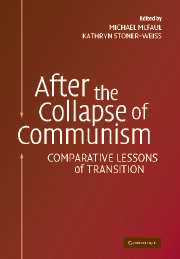Book contents
- Frontmatter
- Contents
- Contributors
- Introduction: The Evolving Social Science of Postcommunism
- 1 The Triumph of Nation-States: Lessons from the Collapse of the Soviet Union, Yugoslavia, and Czechoslovakia
- 2 The Fourth Wave of Democracy and Dictatorship: Noncooperative Transitions in the Postcommunist World
- 3 Circumstances versus Policy Choices: Why Has the Economic Performance of the Soviet Successor States Been So Poor?
- 4 Whither the Central State? The Regional Sources of Russia's Stalled Reforms
- 5 Parties, Citizens, and the Prospects for Democratic Consolidation in Russia
- 6 Comparative Democratization: Lessons from Russia and the Postcommunist World
- 7 Russians as Joiners: Realist and Liberal Conceptions of Postcommunist Europe
- Index
4 - Whither the Central State? The Regional Sources of Russia's Stalled Reforms
Published online by Cambridge University Press: 07 September 2011
- Frontmatter
- Contents
- Contributors
- Introduction: The Evolving Social Science of Postcommunism
- 1 The Triumph of Nation-States: Lessons from the Collapse of the Soviet Union, Yugoslavia, and Czechoslovakia
- 2 The Fourth Wave of Democracy and Dictatorship: Noncooperative Transitions in the Postcommunist World
- 3 Circumstances versus Policy Choices: Why Has the Economic Performance of the Soviet Successor States Been So Poor?
- 4 Whither the Central State? The Regional Sources of Russia's Stalled Reforms
- 5 Parties, Citizens, and the Prospects for Democratic Consolidation in Russia
- 6 Comparative Democratization: Lessons from Russia and the Postcommunist World
- 7 Russians as Joiners: Realist and Liberal Conceptions of Postcommunist Europe
- Index
Summary
INTRODUCTION
This chapter argues that one important and often underemphasized reason for Russia's uneven economic recovery lies in the nature and evolution of political and economic decentralization. Following the collapse of the Soviet Union in December 1991, the Russian central state's ability to project its economic regulatory authority and reliably implement its policies in the provinces was seriously eroded. Indeed, the situation had become so desperate that among President Putin's first acts in office in May of 2000 were a reorganization of his presidential administration and the passage of a series of laws designed to reinforce federal authority beyond the Kremlin. In doing so, he attempted to address what has become one of Russia's most significant developmental challenges since the collapse of the Soviet Union – the central state's capability to govern in the periphery.
Beginning in 1990, a year prior to the ultimate demise of the Soviet Union, Russia's regions gained tremendous authority relative to their status under Soviet rule. Under the Soviet system, the country was so highly centralized that even trains as far as nine time zones away ran according to Moscow time; regional government officials were appointed and dismissed at the pleasure of the leadership of the Communist Party of the Soviet Union; and all prices and trade were controlled by central planners in Moscow.
- Type
- Chapter
- Information
- After the Collapse of CommunismComparative Lessons of Transition, pp. 130 - 172Publisher: Cambridge University PressPrint publication year: 2004
- 4
- Cited by



